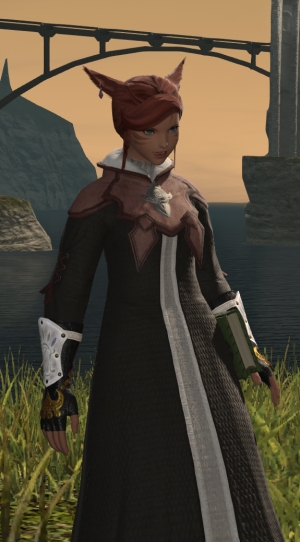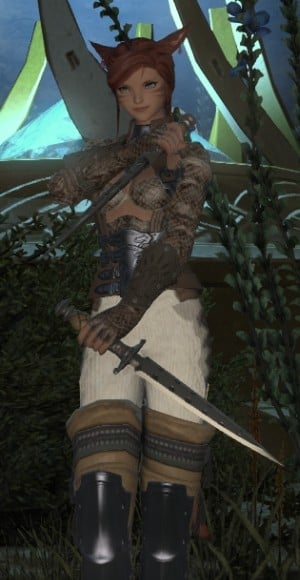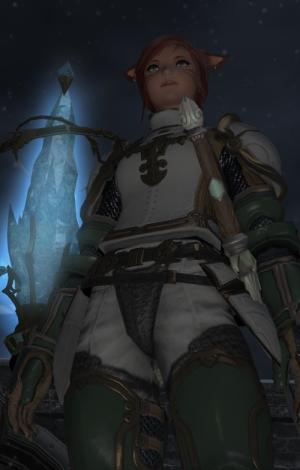
The answer to both is largely level 20, for the record.
Let’s assume, then, that you’re starting the game new for the first time. Once you’ve made your character (and your birthdate and starting deity have minimal effect upon your character, so don’t sweat them) and watched the far-too-long opening cutscene, you’re dropped into a quick series of tutorial quests. What do you do from there, where do you go, and how do you make the most out of your time in Final Fantasy XIV when we’re on the cusp of the game’s first expansion?
 Stage 1: Follow the Class
Stage 1: Follow the Class
The tutorial quests you get will lead you in the direction of your class guild, and this is important. While you’re there, you can pick up your first class quest. These quests are available every five levels, and doing them is one of your highest priorities. Aside from helping to teach you in broad strokes how you class plays, you also earn new abilities and unlock your far more powerful Job options via class quests. Do not neglect them.
The first class quest will also unlock your Hunting Log (bound to “H” by default). This is also an important part of the leveling process, but at least early on you don’t need to worry about it too much. Killing the right number of the listed targets gets you a boost of experience; killing all of the listed targets gets you a bigger boost. Just doing your starting quests and noticing the targets you need to kill will be enough to clear out the first two portions of the log, and fully unlocking the Hunting Log is not necessary for your class. It’s just another way to earn experience.
Stage 2: Understanding the Flow
FFXIV has a strictly linear story; there are no alternate routes to be followed. At the same time, the story will bring you all across Eorzea and frequently take you back to areas you thought you were finished with. The game makes use of this for quest distribution purposes, too.
Essentially, there are no straight quest hubs. Instead, around each leg of the main story you will find several auxiliary quests located around that main quest. The first time through, this is a very big advantage. Quests cannot be repeated, and the ones you can do at a low-level go a long way toward boosting the heck out of your levels. (Subsequent leveling experiences lack the directed questing, although you get another boost to help compensate in part.) Between the main story and satellite quests along with the occasional hunting entry or FATE, reaching level 10 will not be an issue.
That’s when you’ll unlocking things. Speaking of which…
 Stage 3: The First Unlocks
Stage 3: The First Unlocks
Almost every unlock in Final Fantasy XIV is tied to quests rather than level. This can feel slightly irritating, but it prevents situations like unlocking a new dungeon in World of Warcraft without even realizing that it’s there. Not that I’ve ever done that several dozen times or anything.
Cough.
The level 10 story quests unlock Levequests (not necessary for leveling your first class for most of the game) and retainers. Retainers are “hired” but don’t actually cost you any money in-game; they’re your functional bank and auction system all in one. And yes, you can spend a great deal of time customizing the appearance of your retainer if you’re so inclined.
Meanwhile, your level 10 class quest unlocks the option to pick up additional classes. This is vital. Whatever city you started in will have a gathering class, at least two crafting classes, and two more combat classes available. You don’t need to play these additional classes, but… you also kind of do; they’re important. They offer cross-class abilities that are vital. That having been said, you don’t need to worry too much about them right now and can safely wait until level 15.
If you want to play a Rogue, you have to get level 10 and switch to the class first. However, if that’s your plan, I recommend you start as a Pugilist or Lancer first, even though that means you’ll have to wait a little bit longer to unlock Rogue. Just keep heading along until you reach the level 15 story quests, and that’s when you can start in on…
 Stage 4: Opening Up
Stage 4: Opening Up
By this point, you will have earned your first class ability specifically from your class quests by completing your level 15 class quest. Hooray for you! You’ll also be speeding along the main scenario, winding up with a quest dubbed Call of the Sea regardless of your starting nation. Having done the prior quest, you’ll be pointed to Limsa Lominsa, and you’ll have access to airships as a travel method between all three cities. This means you now have the ability to unlock all of the various classes and try all of the different playstyles.
If you want to play just as a crafter or gatherer, that’s commendable, but you still want to stick with your combat class for a little while longer. It’ll be worthwhile.
Call of the Sea is the point when all three nation storylines come together into one, and once you’ve cleared that and unlocked the next main scenario quest, stop for a moment. Look around. There’s a questgiver name I’tolwann right near where you’re standing, and she gives you the quest Rising to the Challenge. The quest takes you two seconds to complete and unlocks the Challenge Log, which is a great way of both getting experience and guiding your play.
In short: The Challenge Log lists several objectives that can be completed each week. Several of these objectives reward experience, most reward gil, and all of them can serve as an effective guide if you’re not sure what you want to do next. Make good use of it. And yes, several of the challenges involve crafting or gathering classes, hence why I encouraged you to keep going to unlock it.
Continuing on the main scenario quests unlocks the first dungeon in the game, Sastasha. It’s not a terribly hard dungeon, but it’s fun. Once you unlock the second dungeon, you can start using the Duty Roulette, which queues you up for a random dungeon that you’re eligible to enter. You get bigger rewards for the roulette, and there’s a challenge to enter the roulette a certain number of times, so it’s generally worth the effort.
This is also the time to start worrying about unlocking and playing other classes. It’s not mandatory yet, no, but you can benefit from doing so. As you level another class, you likely won’t have many quests around you, if any, but you’ll probably notice that you’re leveling slightly faster. Every class after your first one unlocks an Armoury Bonus that grants you more experience based on the gap between your highest-level class and your current class; it makes leveling additional classes very quick at low levels when you cap out.
At this point, you have your challenge log unlocked, you’ve gotten into dungeons, and you can unlock multiple classes. Whew. And there’s a bunch more to still go. So I’m going to have to split this up a bit further. You can feel free to leave comments, feedback, and questions in the comments below or send mail along to eliot@massivelyop.com; both work just as well. Next time out, I’ll be talking about unlocking jobs, ventures, Grand Companies, and all the options you have for play past the early levels.















